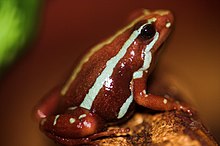Epipedobates
| Epipedobates | |
|---|---|

| |
| Epipedobates tricolor | |
| Scientific classification | |
| Kingdom: | Animalia |
| Phylum: | Chordata |
| Class: | Amphibia |
| Order: | Anura |
| Family: | Dendrobatidae |
| Subfamily: | Colostethinae |
| Genus: | Epipedobates , 1987 |
| Type species | |
| Prostherapis tricolor Boulenger, 1899
| |
| Diversity | |
| 7 species (see text) | |
Epipedobates is a genus of poison dart frogs native to northern South America (Colombia and Ecuador) west of the Andes, including the western slopes. Common name phantasmal poison frogs has been suggested for the genus.[1]
Taxonomy[]
Epipedobates was erected in 1987 in an attempt to split dendrobatids into monophyletic genera, accommodating species that had until then been placed in Phyllobates. In the major revision of poison dart frogs in 2006, most of the species formerly placed in Epipedobates were then transferred to Ameerega, leaving behind just five species.[2] With description of new species, the species count had increased to seven by early 2015.[1][3]
Description[]
Dorsal colouration is cryptic, brown. A pale oblique lateral stripe is present. Dorsal skin is smooth or with irregularly scattered granules or tubercles, most distinct and prevalent posteriorly. In adult males, third finger is swollen.[2]
Species[]
There are seven species:[1][3]
| Image | Scientific name | Common name | Distribution |
|---|---|---|---|
 |
Epipedobates anthonyi (Noble, 1921) | Anthony's poison arrow frog | Ecuador and Peru. |
| Epipedobates boulengeri (Barbour, 1909) | marbled poison frog or marbled poison-arrow frog | Colombia (Cauca, Nariño, Valle del Cauca Departments, including Gorgona Island) and northwestern Ecuador | |
 |
Cisneros-Heredia and Yánez-Muñoz, 2011[4] | Darwin Wallace Poison-Frog | Ecuador |
| Epipedobates espinosai (Funkhouser, 1956) | Ecuador | ||
| Epipedobates machalilla (Coloma, 1995) | West Ecuador | ||
| Mueses-Cisneros, Cepeda-Quilindo, and Moreno-Quintero, 2008 | Colombia | ||
 |
Epipedobates tricolor (Boulenger, 1899) | Phantasmal poison frog | Ecuador |
References[]
- ^ a b c Frost, Darrel R. (2015). "Epipedobates Myers, 1987". Amphibian Species of the World: an Online Reference. Version 6.0. American Museum of Natural History. Retrieved 17 April 2015.
- ^ a b Grant, T.; Frost, D. R.; Caldwell, J. P.; Gagliardo, R.; Haddad, C. F. B.; Kok, P. J. R.; Means, D. B.; Noonan, B. P.; Schargel, W. E. & Wheeler, W. C. (2006). "Phylogenetic systematics of dart-poison frogs and their relatives (Amphibia: Athesphatanura: Dendrobatidae)" (PDF). Bulletin of the American Museum of Natural History. 299: 1–262. doi:10.1206/0003-0090(2006)299[1:PSODFA]2.0.CO;2.
- ^ a b "Dendrobatidae". AmphibiaWeb: Information on amphibian biology and conservation. [web application]. Berkeley, California: AmphibiaWeb. 2015. Retrieved 17 April 2015.
- ^ Cisneros-Heredia, D. F. & M. H. Yánez-Muñoz (2010). "A new poison frog of the genus Epipedobates (Dendrobatoidea: Dendrobatidae) from the north-western Andes of Ecuador" (PDF). Avances en Ciencias e Ingeníerias, Sección B. 2 (3): 83–86. Archived from the original (PDF) on 2017-08-10. Retrieved 2014-12-20.
- Epipedobates
- Poison dart frogs
- Amphibians of South America
- Amphibian genera